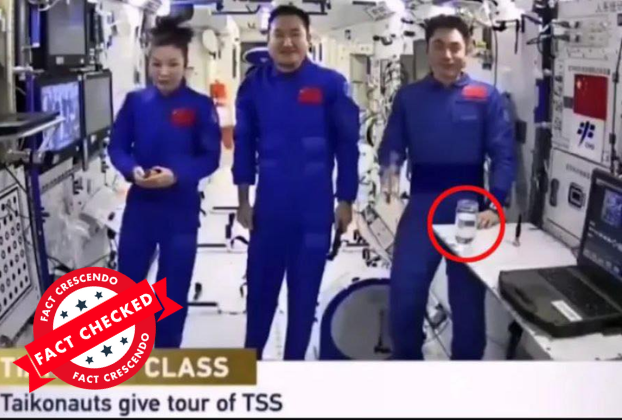A viral video showing a glass of water resting calmly on a table aboard China’s Tiangong space station sparked a wave of conspiracy theories. Some viewers argued that if the video were truly filmed in microgravity, the water should have floated out of the glass or formed blobs. Based on this misunderstanding, they claimed the footage was staged or filmed on Earth. However, the water behaviour in the questioned video is consistent with the laws of physics.
Social Media Posts
Social media users have shared a video of China’s Tiangong space station, highlighting that water remains still in a glass rather than floating in the air, contrary to their expectations. These posts suggest that China is faking the space station.
Below is another instance of the same claim
These viral videos began circulating in late 2021 and early 2022, coinciding with China’s Shenzhou-13 mission educational demonstrations. The clips show Chinese astronauts conducting science experiments aboard the Tiangong space station, with critics pointing to the water’s behaviour as “evidence” of deception.
Fact Check
A keyword search and a reverse image search led us to the original footage, which comes from a 2021 Tiangong Class science lecture aboard the space station during the Shenzhou-13 mission.
Astronaut Wang Yaping demonstrated the difference between buoyancy in microgravity versus Earth by placing a ping-pong ball in water. Unlike on Earth, where the ball floats to the surface, in microgravity it remained suspended within the water. This was part of an educational science demonstration.
Critics claimed the water should float around in blobs, but there’s a scientific explanation for why it stays in the glass. In microgravity, surface tension becomes the dominant force – water molecules attract each other strongly, keeping the water together rather than dispersing. The water also clings to the glass through adhesion.
Experts Confirm That The Observation is Consistent with Established Fluid Physics Principles in Microgravity Environments.
Space historian Jordan Bimm explained to AP: “Water molecules like to stick to glass and also to other water molecules more than they like to disperse in the air… water remains in ‘clumps’ in the weightless environment, and in this case inside the glass.”
This behaviour is consistent with observations from both the International Space Station (ISS) and Tiangong space stations, where surface tension keeps liquids contained rather than floating away.
Official footage from the CMSEO (China Manned Space Engineering Office) shows how astronauts conducted the water demonstration. They filled the glass carefully using a straw and secured it to the table with Velcro or adhesive strips. This anchoring prevented both the glass and water from floating away in microgravity, explaining why everything remained stationary during the demonstration.
Response from China’s Space Program
China’s crewed space program directly addressed the conspiracy theories by releasing behind-the-scenes footage on Weibo. The video shows astronaut Wang Yaping carefully pouring water into the glass using a straw, then securing it to the work surface with adhesive strips. In a follow-up demonstration, the crew submerged a ping-pong ball in the water. Unlike on Earth, where buoyancy would cause the ball to float to the surface, it remained suspended underwater in the weightless environment. This behaviour provides additional evidence that the physics observed match microgravity conditions in space, not terrestrial filming.
Microgravity physics and Newton’s First Law
In microgravity, objects like water and containers stay in place unless something pushes or pulls them. Since nothing disturbed the water in the video, it remained still in its glass. This is a perfect example of Newton’s First Law: objects at rest stay at rest unless acted upon by an external force.
The behaviour observed in the video aligns with experiments conducted on the International Space Station. Studies have shown that liquids in microgravity environments typically form spherical droplets due to surface tension and can adhere to surfaces differently than on Earth. (Source)
Independent Verification of Tiangong’s Existence
Multiple international space agencies, including NASA, have independently tracked and catalogued the Tiangong space station. The U.S. government’s NASA/GSFC National Space Science Data Centre (NSSDCA) lists “Tiangong-1” as an official entry among tracked spacecraft, reflecting how U.S.-based orbital monitoring systems continuously record and analyse Chinese space missions.
Additionally, various satellite tracking resources, including NASA’s Spot the Station app and Heavens-Above website, provide visibility information for the Tiangong station. These tracking systems monitor the station’s orbit and ground track using independent data sources. This allows observers to predict when Tiangong will pass overhead, with these predictions being verified by actual sightings from multiple locations around the world. (Source)
Conclusion:
The water’s behaviour in the Tiangong space station videos is entirely consistent with established physics principles governing liquids in microgravity environments. Surface tension, molecular adhesion, and Newton’s First Law explain why water remains contained within secured glasses rather than floating freely. Independent tracking by international space agencies confirms Tiangong’s existence, while expert analysis validates the scientific accuracy of the observed phenomena. These conspiracy theories stem from fundamental misunderstandings of how fluids behave in space.

Title:Debunked: Water Behaviour on China’s Space Station Doesn’t Prove It’s Fake!
Fact Check By: Cielito WangResult: False






